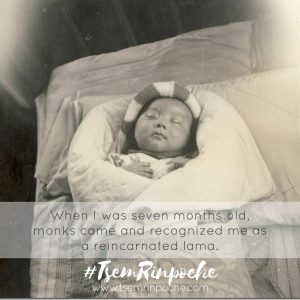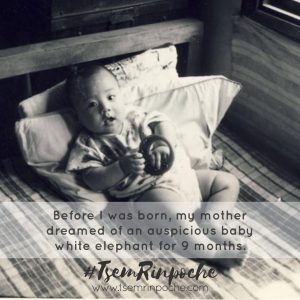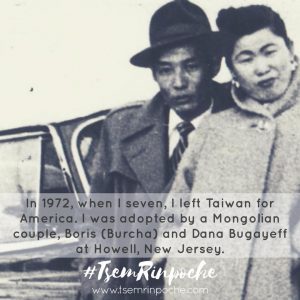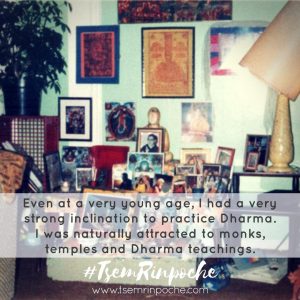My take on Rinpoche’s Story
19 Oct
 I was doing a reading of my book ‘Tales My Lama Told Me’ to a live audience, which was also screened live onto Facebook a week ago. Rinpoche’s birth and formative years had many aspects of what you would call a fantastic story of a high lama, from the miraculous dreams that Rinpoche’s mother had to his increasing interest in the Dharma, natural faith in the Buddhas to Rinpoche’s emerging passion to becoming a monk.
I was doing a reading of my book ‘Tales My Lama Told Me’ to a live audience, which was also screened live onto Facebook a week ago. Rinpoche’s birth and formative years had many aspects of what you would call a fantastic story of a high lama, from the miraculous dreams that Rinpoche’s mother had to his increasing interest in the Dharma, natural faith in the Buddhas to Rinpoche’s emerging passion to becoming a monk.
It was obvious from reading Rinpoche’s story that he was vastly different from other people. Growing up in America, the land of the American Dream did not exactly made him a believer in that ‘dream’. In fact, his foster parents were the perfect example of that pursuit and the fact that everyone else were dying to live the dream except for Rinpoche. He could easily see through it that people are not contented and happy in spite of having what most middle-income families are living and dying to have more of. The American Dream is just a symbolic of people’s (from all over the world) illusory belief that having a career, family, romance and all that it entails would make us happy.

In fact, our whole idea of what brings happiness is culturally driven, reinforced by popular culture, media and our upbringing. It is so entrenched in our psyche that everybody knows intellectually that having such things does not really bring happiness but we are seduce by it and often mislead to think otherwise. Rinpoche witnessed this in the endless cycle of self-made problems that his parents, relatives and friends were going through. They pursued the American Dream just like everyone else but nobody was truly contented. In recent teachings, he said that if money, lovers, spouses and other secular achievements brought happiness, then we should become happier if we had more. However, this is is not true and with that line of thinking we can see the transient nature of happiness derived from worldly accomplishments. He feels the way out is through the Dharma, which unfortunately was not accepted by his foster parents. That is why Rinpoche left home and pursued Dharma all the way and became a monk.
Furthermore, Rinpoche’s childhood was a living proof of the existence of reincarnation. From a young age, Rinpoche already had natural faith in the Buddhas, he would draw and later photocopy images of the Buddha that he found in books. He did all that because he felt that the Buddhas can protect people. Nobody taught him to venerate the Buddhas in this manner. Living in America, he grew up in a totally materialistic society and nobody had really encouraged or inspired him. All of it came from him and there was nothing in this life that inspired him, then it must have come from a previous life. Such things are not unique of high lama incarnations as it happens to ordinary folks as well. Some people are child geniuses in the field of music, science, maths and so forth. These people pick up complicated concepts easily as if they were merely rekindling an old memory. They must have learned these things from a previous life and something triggered the memory and they become expert in their respective fields.
 In a similar manner, high lama incarnations are able to pick up the teachings easily and aside from just knowledge, high lamas are also attained. Spiritual attainments once acquired, can be brought over into future lives. In fact, many high lamas are able to determine their future rebirths. Due to these facts, we can safely determine that there are future lives since there are ample evidence that supports the case of previous lives. Since we have established that there are past and future lives just by examining Rinpoche life, we can start to look into this life and self-examine what have we done to prepare for our future lives. Logically speaking, none of the what we do with our families, businesses, careers, traveling and so forth will prepare us for our future rebirths. It is only with our meagre Dharma practice that can help us at the time of death. Therefore, it is important to re-examine the role of our Dharma practice in shaping the destiny of our future lives and striking that balance between the secular and our spiritual practice.
In a similar manner, high lama incarnations are able to pick up the teachings easily and aside from just knowledge, high lamas are also attained. Spiritual attainments once acquired, can be brought over into future lives. In fact, many high lamas are able to determine their future rebirths. Due to these facts, we can safely determine that there are future lives since there are ample evidence that supports the case of previous lives. Since we have established that there are past and future lives just by examining Rinpoche life, we can start to look into this life and self-examine what have we done to prepare for our future lives. Logically speaking, none of the what we do with our families, businesses, careers, traveling and so forth will prepare us for our future rebirths. It is only with our meagre Dharma practice that can help us at the time of death. Therefore, it is important to re-examine the role of our Dharma practice in shaping the destiny of our future lives and striking that balance between the secular and our spiritual practice.
In a nutshell, my take on Rinpoche’s life is on this two important points. The first point is that from a very young age, he perceive the truth of ordinary secular life and had always sought to practice the Dharma. This culminated in him taking ordination and continue to hold his monastic vows ever since. The other point is that Rinpoche’s life and in particular, his childhood predilection towards the Dharma is ample proof of previous lives and naturally, future lives as well. Hence, his life in essence is an inspiration on my many levels and on one level, it encourages us to prepare for our inevitable future lives. 
For Rinpoche’s full story, check out the Promise here – https://www.tsemrinpoche.com/tsem-tulku-rinpoche/me/tsem-rinpoches-inspiring-biography-now-in-ebook-format.html





No comments yet